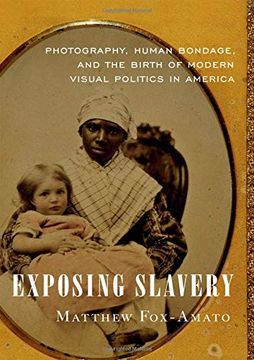Share
Exposing Slavery: Photography, Human Bondage, and the Birth of Modern Visual Politics in America (in English)
Matthew Fox-Amato
(Author)
·
Oxford University Press, USA
· Hardcover
Exposing Slavery: Photography, Human Bondage, and the Birth of Modern Visual Politics in America (in English) - Fox-Amato, Matthew
$ 36.09
$ 48.99
You save: $ 12.90
Choose the list to add your product or create one New List
✓ Product added successfully to the Wishlist.
Go to My WishlistsIt will be shipped from our warehouse between
Friday, May 24 and
Monday, May 27.
You will receive it anywhere in United States between 1 and 3 business days after shipment.
Synopsis "Exposing Slavery: Photography, Human Bondage, and the Birth of Modern Visual Politics in America (in English)"
Within a few years of the introduction of photography into the United States in 1839, slaveholders had already begun commissioning photographic portraits of their slaves. Ex-slaves-turned-abolitionists such as Frederick Douglass had come to see how sitting for a portrait could help them project humanity and dignity amidst northern racism. In the first decade of the medium, enslaved people had begun entering southern daguerreotype studios of their own volition, posing for cameras, and leaving with visual treasures they could keep in their pockets. And, as the Civil War raged, Union soldiers would orchestrate pictures with fugitive slaves that envisioned racial hierarchy as slavery fell. In these ways and others, from the earliest days of the medium to the first moments of emancipation, photography powerfully influenced how bondage and freedom were documented, imagined, and contested. By 1865, it would be difficult for many Americans to look back upon slavery and its fall withoutthinking of a photograph. Exposing Slavery explores how photography altered and was, in turn, shaped by conflicts over human bondage. Drawing on an original source base that includes hundreds of unpublished and little-studied photographs of slaves, ex-slaves, free African Americans, and abolitionists, as well as written archival materials, it puts visual culture at the center of understanding the experience of late slavery. It assesses how photography helped southerners to defend slavery, enslaved people to shape their social ties, abolitionists to strengthen their movement, and soldiers to pictorially enact interracial society during the Civil War. With diverse goals, these peoples transformed photography from a scientific curiosity into a political tool over only a few decades. This creative first book sheds new light on conflicts over late American slavery, while also revealing a key moment in the relationship between modern visual culture and racialized forms of power and resistance.

